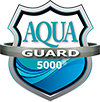This “chalking” of the AquaGuard surface, is a new concern that has only arisen in the last couple of years. Since you first raised this concern, we have surveyed a handful of certified AquaGuard 5000 dealers nationwide and found this to be an isolated issue experienced by those in the South Florida Water Management District, from Daytona to Boca Raton. After having those contractors test the waters in the effected pools, we found that in each of the pools tested, the water chemistry did not meet our warranty standards for recommended pool care. Therefore, we believe the problems are being caused by well water being added to pools, as well as a few municipalities’ replacement water. We have also found that pools with salt water generators can have even heavier fallout and/or plating of the AquaGuard surface.
Calcium Fallout
Calcium Fallout can occur when unbalanced calcium levels cause water to become increasingly unstable, especially when combined with unusually high Ph or total alkalinity levels. This can again result in cloudy water and/or scaling. In addition, warmer water temperatures, as seen in South Florida in the summer time can exacerbate this issue since calcium becomes more likely to precipitate out of the solution in warmer water.
Water that is lacking in calcium will aggressively leach calcium from the plaster surface of the pool in an effort to equalize itself. In a fiberglass or vinyl pool, the calcium deficient water will start to erode metal fixtures or fittings and heat exchangers for the same reason. When such corrosion occurs, it is also common for stains to appear, which over time will damage the fiberglass or vinyl surface.
Often in these cases, we have found that homeowners and/or pool maintenance companies are not brushing the pool’s surface regularly, which is essential to the pool’s care. Brushing disrupts the sediment, sending the particles through the pool’s water filtration system.
Where an improperly maintained concrete surface pool would scale or stain, a pool that has been surfaced with AquaGuard can have the problem resolved with chemical adjustment and brushing of its surface. In extreme cases, it may be necessary to add a sequestering agent to the water (there are many to choose from at a local pool store). The addition of the sequestering agent will coagulate or consolidate these particles allowing the pool’s filtration system to capture these particles more efficiently. It is very important to keep a clean filter and replace the filter’s sand media every five years religiously.
The Taylor Test Kit
It is extremely important to stress to all our customers to maintain their pools to the Taylor Test Kit guidelines at all times, see below.
Your new AquaGuard surface will require less maintenance over time and reduce the amount of chemicals necessary to properly balance your pool’s chemistry. We recommend the following care instructions:
A. When filling a pool a sequestering agent should be used to suspend any mineral particles until the filtration system is in service.
B. Maintain the following pool chemistry levels:
- Chlorine 1.5 – 2.0 ppm
- Acidity 7.4 – 7.8 Ph
- Alkalinity 90 – 120 ppm
- Calcium 250 – 350 ppm
- Stabilizer 60 – 90 ppm
C. Precaution: Do not allow tri-chlor powder, tablets or stabilizers to settle directly on the surface. This may result in staining or discoloration of the AquaGuard surface.
D. Low calcium and high chlorine levels can cause plating, and precipitates to adhere to the surfaces.
E. Not regularly cleaning & waxing areas in direct sunlight will result in discoloration.
